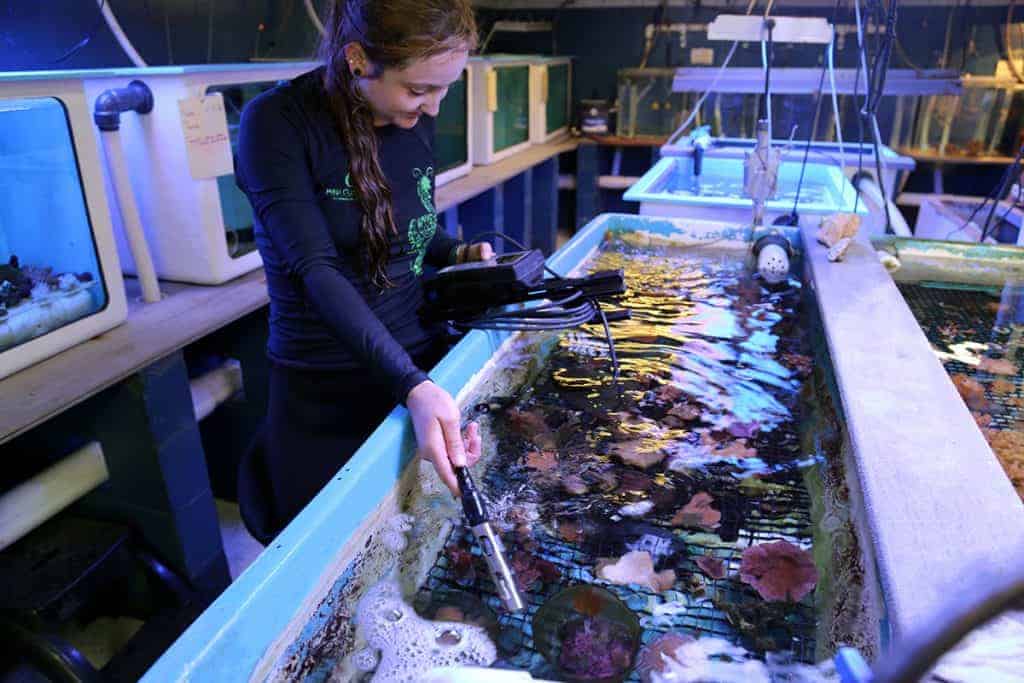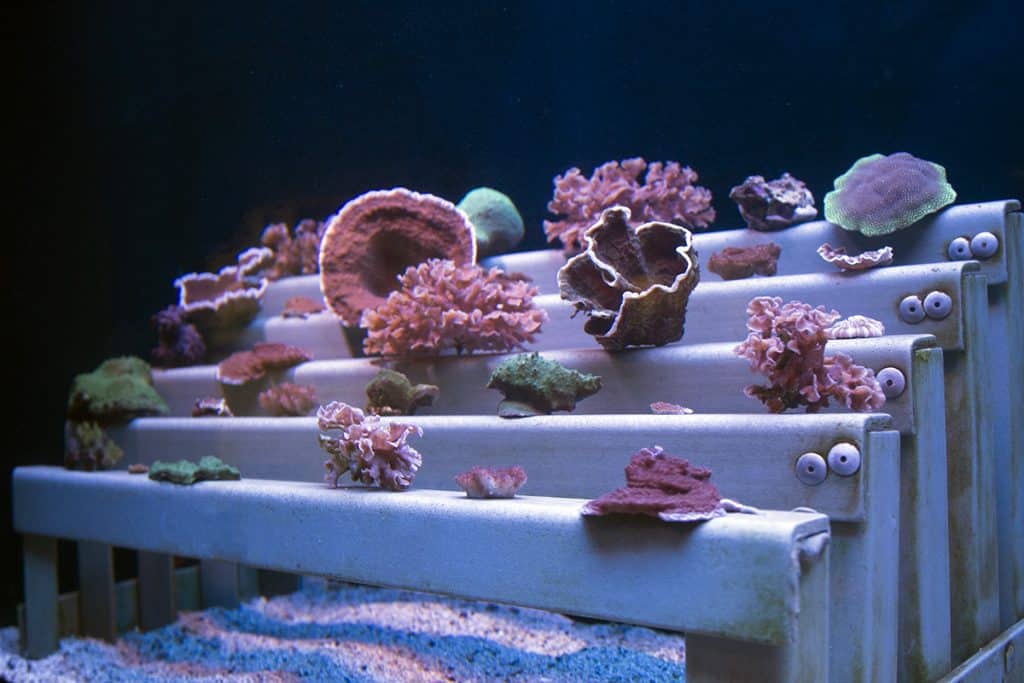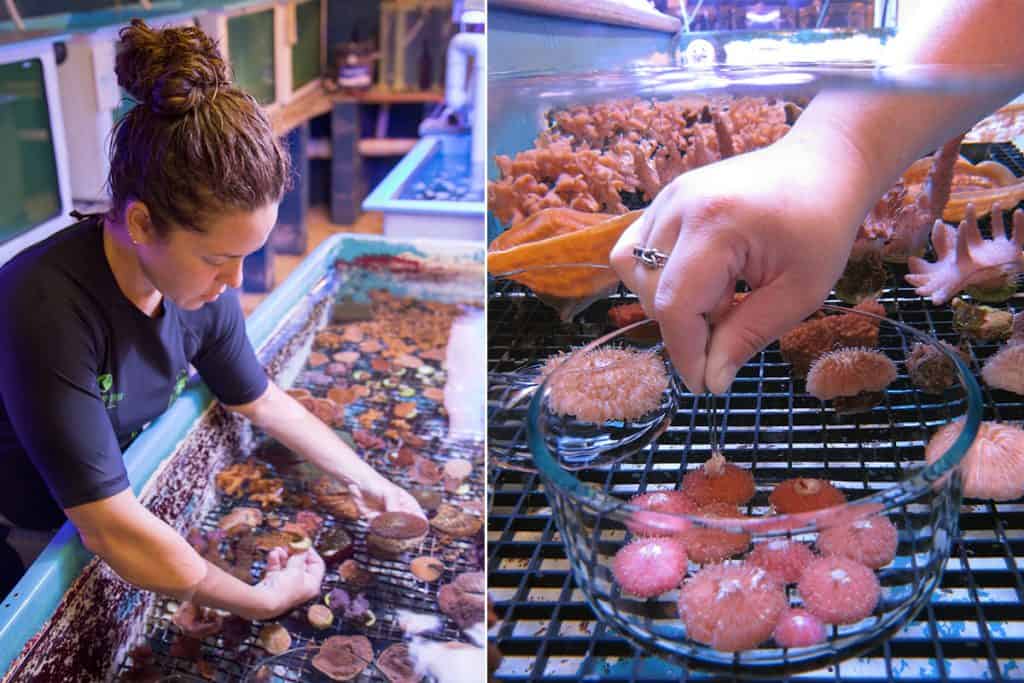Under a sky of fluorescent lights, young corals rest in a trough of seawater. The only sounds are of flowing water and bubbles churning at the surface; if you close your eyes, you could imagine yourself on the Amazon River during a rainstorm. But all is calm in this sanctuary known as the Aquarium Lab where Hawaiian corals grow unrestricted by the barriers of climate change or dangers posed by anthropogenic influences. While they currently live in a controlled environment, these corals are being groomed for a special purpose and mission.

Aquarists regularly check water temperature and pH levels to ensure optimal water conditions are maintained for corals and marine life at Maui Ocean Center.
Maui Ocean Center’s Aquarium Lab is home to a team of aquarists who have spent years honing the art of coral propagation (reproduction by fragmenting nubbins from a parent coral) and transplantation techniques. In 2012, the lab served as ground-zero for several coral mitigation (saving corals at risk of being destroyed) and transplantation operations in collaboration between Maui Ocean Center, the State’s Department of Land and Natural Resources Division of Aquatic Resources (DNLR/DAR) and Division of Boating and Ocean Recreation, and NOAA.
The Aquarium Lab was utilized through 2015 to help transplant over 700 pieces of corals in Hawaii that were at risk due to necessary construction repairs at harbors and piers.

In anticipation of such events, the lab functions as a “farm” to raise corals with best practices learned from coral researchers within DAR’s Coral Restoration Nursery who specialize in fast-growing techniques. Like a Rubik’s Cube, it takes the right combination of variables to complete the puzzle. Substrate type and shape, light intensity and duration, water flow, algae control, and more are considered when trying to help accelerate a coral’s average growth rate of a quarter inch per year.

Hawaiian coral species are propagated at the Aquarium with the goal of being transplanted out to coral reefs.
“Coral transplantation can be viewed as a tool in the box, but it is not the sole solution,” said John Gorman, Head Curator at Maui Ocean Center, “creating marine protected areas, reducing fishing pressures on herbivores, limiting runoff, and finding alternatives to certain types of sunscreen are other tools to consider when looking at the future of Hawaii’s coral reefs.”
Like the coral transplantation projects of the past, Maui Ocean Center is a part of a family of coral conservation pioneers including DAR’s Coral Restoration Nursery (Sand Island, Oahu), Waikiki Aquarium (Honolulu, Oahu), Hawaii Institute of Marine Biology (Kaneohe, Oahu), and a relatively new partner, the Maui Ocean Center Marine Institute (Ma‘alaea, Maui). While each may have a different approach to solving the riddle, they are all forging paths that lead to the same outcome of protecting Hawai’i’s fragile coral reefs.
With growing public awareness about the importance of coral reefs, the expanding number of environmental non-profits and research facilities, and local laws being passed to reduce human impacts on natural resources, one can hope that Hawaii is entering the beginning of a “coral renaissance”.

In the meantime, behind the Aquarium Lab’s blue steel door, the aquarists continue to raise corals, learn what works and what doesn’t, and collaborate with coral biologists from around the world. It is the team’s goal that when the day comes to transplant again, they would be able to bring out one of the sharpest tools in the box.
“Ka Mo‘olelo Moana,” or “The Ocean Story,” is a monthly column written by Maui Ocean Center and published in The Maui News.
Immerse Yourself in our SEA-News featuring Hawaiʻi’s marine life, inspirational conservation, and glimpses behind-the-scenes.